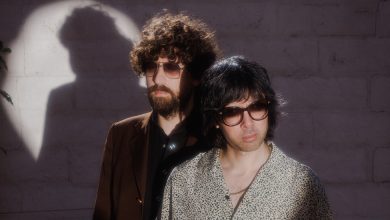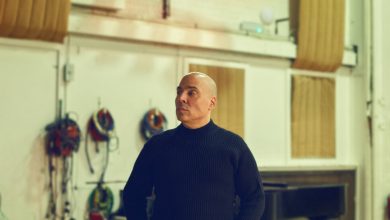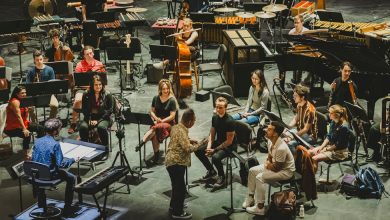When ‘Boo!’ Is Only the Beginning

Surfacing
When ‘Boo!’ Is Only the Beginning
What does it take to scare the candy corn out of someone? Performers at two of New York’s hallowed haunted attractions explain the secrets behind the shocks.

Keenan Loughney, who portrays a nurse at Headless Horseman in Ulster Park, N.Y.
By Alexis Soloski
Photographs by Erik Tanner
Angie Hansen knows what she wants: energy, professionalism, a gift for ad-lib. “And then somebody that really likes to scare people,” she said cheerfully.
As the creative director of Blood Manor, a 10,000-square-foot haunted house nestled inside a TriBeCa skyscraper, Hansen assembles 60 performers annually, many of them Blood Manor veterans. She sorts the newcomers into appropriate roles — clowns, killers, corpse brides, victims weeping silicone wounds. In just three or four days of rehearsal, she teaches them to terrify the thousand or so guests who enter Blood Manor, a Halloween staple since 2005, each weekend evening.
About two hours north, at Headless Horseman in Ulster Park, N.Y., David Berman leads acting workshops for seasonal scare actors. Because it takes more than ghoulish makeup and vibrating vocal cords to make ticket holders scream.
“To just jump out of a closet and just yell, it doesn’t do anything,” Berman said.
Such haunts — the industry term for a variety of haunted attractions — became popular in the 1980s. Spencer Terry, the president of the Haunted Attractions Association, a trade group, estimates that there are about 1,800 professional haunts in the United States this year. While horror now thrives in sundry forms, these destinations offer something entirely immersive, a 360-degree experience in which audiences can star in their worst nightmares.
Even as professional attractions move toward more extreme effects — animatronic monsters, plummeting elevators, rippling walls — most still depend on the potential of the human body alone. (Well, the human body and some terrifying face painting.) “Yes, you can scare folks with jump scares, or even puffs of air,” said Beth Kattelman, a professor of performance at Ohio State University. “But what people really remember are the characters, the special things that folks do.”
Before Michael Jubie opened Headless Horseman nearly 30 years ago, he worked as a commander of a mounted police unit in Kingston, N.Y. He still projects extreme stoicism, and yet, his actors regularly frighten him. “Oh, I’ve been scared,” he said. “Oh, yes.”
In the weeks leading up to Halloween, we spoke to some of the actors of Blood Manor, amid the hustle of New York City, and Headless Horseman — which operates escape rooms, haunted houses and a very scary corn maze on 65 acres a half-hour drive from the nearest train station — about how they make those scares happen.
While some haunted houses use trained actors, most fill their ranks with enthusiastic amateurs. Before the pandemic, applicants came in for interviews and auditions. Now they typically audition remotely, scaring the camera. What makes a great haunt actor? “There has to be at least a little something off about you,” said Will Szigethy, a longtime Headless Horseman actor. But not too off. Most haunts run background checks.
Scott Taylor, a packaging engineer for Avon by day, has worked at Headless Horseman for 10 years, with nine of them spent playing a very unsettling clown. “You can tell the people whose heart is in it,” he said. “And you can tell the people that are here just for a paycheck. Those people don’t usually last very long.”
Veterans take first-timers under their wings, helping them improve their personae and teaching them to scream without shredding their throats. (The trick: Howl from the diaphragm.) Over the course of a season, newcomers will refine characters based on their environment — a morgue, a cemetery, a sideshow — finding distinctive ways to move, to scream, to wield a chain saw or an ax. They will also find their rhythms: a horror variant on comic timing, with a shriek in place of a punchline.
Shamia Diaz, a Blood Manor regular, plays the Bride, an asylum escapee. In her blood-smeared hands, the role involves a lot of shaking, a lot of screaming, a lot of encouraging attendees to read scripture from the book of Satan. “You have to find your own mojo, your own vibe,” she said. “Because once you find what works for you, you’re unstoppable.”
For Dominique Peres, who joined Headless Horseman five years ago as a painfully shy teenager, mojo meant creating a character called Jacket, an exuberant take on a psycho killer. “Jacket is crazy, has an ax, runs rampant, likes candy, likes to make friends,” she said.
Some performers specialize in jump scares, popping out from unexpected corners. Others prefer more psychological scares, sidling up to ticket holders, whispering in their ears. (Before Covid-19, some haunts allowed performers to do more than just whisper, but Blood Manor and Headless Horseman have always maintained strict no-contact policies.) Others are more versatile. Amateur psychologists, they vary the scare depending on the mood in the room.
Jose Torres, who plays Jack, Blood Manor’s masked serial killer, adjusts his attitude for each new group. “It’s just a connected energy that comes between you and the people walking through,” Torres said.
That energy, however connected, can be difficult to maintain. While a stage actor will perform once or twice per day, a haunt actor may replay the same scene 10 times an hour, for six to eight hours at a stretch. “It is physically strenuous,” said Meagan Donovan, who oversees a haunted house on the Headless Horseman property. “You’re swinging an ax around all night or just hiding in a small space, being loud.”
But the adrenaline rush of eliciting scream after scream keeps performers swinging. “It’s better than a roller coaster,” said Hansen, who spent years playing a Blood Manor victim. “It’s better than sex. It’s better than then the best meal you’ve ever had. The feeling of scaring somebody is what makes you want to do it again and again and again.”
This brand of acting rewards performers in other ways, too. Putting on the makeup and picking up a fake weapon allows them a sense of freedom and disinhibition they may not feel otherwise. “For me, the experience has been very empowering,” Diaz said.
Many also treat haunt acting as a form of stress relief. “They use it as a kind of therapy,” said Berman, who plays a gross-out character named Dewey Tewey at Headless Horseman. “You can’t, in your regular day job, tell somebody you’re going to rip their arms and legs off and toss them into the woods.”
Every so often an actor goes too far, continuing to scare a ticket holder who is obviously already petrified. But most know when to quit or even how to lend a helping, blood-covered hand, scooting people out of a room without breaking character. Besides, the best scares, many performers said, are the ones they really have to work for.
Nicole Borbone and William Burton, recent college graduates, perform a scene set in Blood Manor’s sinew-stained morgue. They begin with a jump scare, then move into a sequence in which Borbone’s corpse suddenly rises from the table and begs attendees to help her. Burton likes to lock eyes with the customers who look like they’d be tough to scare; Borbone tends to lunge for them. Usually she gets the reaction she wants.
“When I make a grown man scream and fall on his knees,” she said, “I’ve done my job.”
Surfacing is a column that explores the intersection of art and life, produced by Alicia DeSantis, Jolie Ruben, Tala Safie and Josephine Sedgwick.




